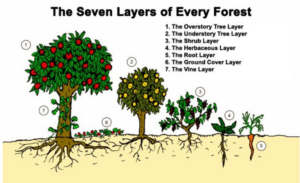4.3 Orchard
Orchard Systems with Guild Planting

A food forest has many stories of plants that produce yields for humans, and support each other with their pollinators, resources, and mimics natural ecosystems. Food forests are a big component of permaculture, and you can find a lot more information about it on websites and books listed below. There is evidence of historical forest gardens that have been found in BC planted by local Indigenous communities (listen here to the Future Ecologies podcast).
The overstory (main crop) of a food forest are the fruit/nut trees trees, with the understory (a companion/guild plant to plant under the main fruit crop). Common overstory fruit trees that grow in the Kamloops area are stone fruits, which include peaches, plums, nectarines, apricots, and cherries.
How can I choose what to plant under my fruit trees to create a guild?
- What else is blooming around that time to attract pollinators?
- What pests are predominant during that bloom time? What plants can deter that pest? What plants will attract a predator to that pest?
- Is there a plant that I can grow and get a yield from them? E.g. garlic, currants, strawberries
You can also use a method called alley cropping under fruit trees, and grow vegetables or perennial crops (e.g. strawberries) under the fruit trees.
Common companion plants under fruit trees:
- Garlic: repel pests and deer, and good yield
- Daffodils: repel deer, attract predatory wasps with early blooms
- Comfrey: compost accelerator, dynamic accumulator (bring up nutrients from deep in the soil)
- Currants: yield of fruit
Further Reading
- The Holistic Orchard by Michael Phillips
- Listen to this Future Ecologies podcast about BC Indigenous forest gardens
